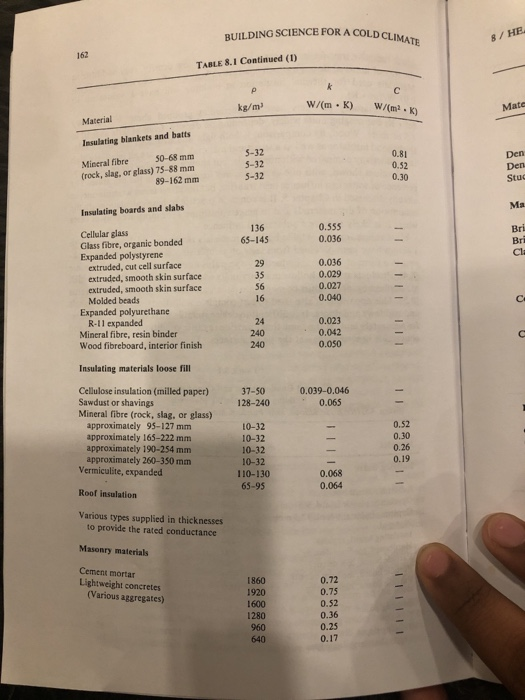Question
A wood frame wall consists of 2x6 wood studs (38mm x 140mm)spaced at 16? o.c. (on centre), with fibreglass batt insulation(see ?insulating blankets and batts




A wood frame wall consists of 2x6 wood studs (38mm x 140mm)spaced at 16? o.c. (on centre), with fibreglass batt insulation(see ?insulating blankets and batts in Tbl. 8.1) between the studs.Each stud is 7?9? long and sits between a 2x6 bottom plate and a2x6 top plate such that each wall ends up being 8? tall (standardheight of a sheet of drywall). The wall is sheathed with 7/16?thick ?hardboard, medium density? (Tbl. 8.1) on the outside, and?9.5mm gypsum or plaster board? (Tbl. 8.1) on the inside. The househas four such walls each measuring 16 feet long by 8 feet tall, andis located in Toronto (heating degree days below 18 = 3653). Thehouse is heated with electricity at a cost of $0.10/KW.h. Don?tforget the air films, and use the winter outside air filmcoefficient. You may also ignore any extra framing details of thecorners. Just find the repeating unit as shown in class and assumeit continues around all four walls.Calculate the area-weighted average RSI-value of the whole wallassembly, area weighting the stud-batt-top/bottom plate layer andthen using the tabular method including the inside and outsidesheathing layers as well as the air films.
162 BUILDING SCIENCE FOR A COLD CLIMATE TABLE 8.1 Continued (1) k 8/HE P C kg/m Material W/(m K) W/(m K) Mate Insulating blankets and batts Mineral fibre 50-68 mm 5-32 (rock, slag, or glass) 75-88 mm 5-32 89-162 mm 5-32 0.81 Den 0.52 Den 0.30 Stuc Insulating boards and slabs Cellular glass 136 0.555 Glass fibre, organic bonded 65-145 0.036 Expanded polystyrene extruded, cut cell surface 29 0.036 extruded, smooth skin surface 35 0.029 extruded, smooth skin surface 56 0.027 Molded beads 16 0.040 Expanded polyurethane R-11 expanded 24 0.023 Mineral fibre, resin binder 240 0.042 Wood fibreboard, interior finish 240 0.050 Insulating materials loose fill Cellulose insulation (milled paper) 37-50 0.039-0.046 Sawdust or shavings 128-240 0.065 Mineral fibre (rock, slag, or glass) approximately 95-127 mm 10-32 approximately 165-222 mm 10-32 approximately 190-254 mm 10-32 approximately 260-350 mm 10-32 Vermiculite, expanded 110-130 0.068 65-95 0.064 Roof insulation Various types supplied in thicknesses to provide the rated conductance Masonry materials Cement mortar Lightweight concretes 1860 0.72 (Various aggregates) 1920 0.75 1600 0.52 1280 0.36 960 0.25 640 0.17 II II 0.52 0.30 0.26 0.19 TLE BRE || 111111 Ma Bri Bri Cla C
Step by Step Solution
3.48 Rating (151 Votes )
There are 3 Steps involved in it
Step: 1
We will first get the RSIvalues of each wall layer and then use the tabular technique to determine the overall RSIvalue in order to calculate the areaweighted average RSIvalue of the entire wall assem...
Get Instant Access to Expert-Tailored Solutions
See step-by-step solutions with expert insights and AI powered tools for academic success
Step: 2

Step: 3

Ace Your Homework with AI
Get the answers you need in no time with our AI-driven, step-by-step assistance
Get Started


